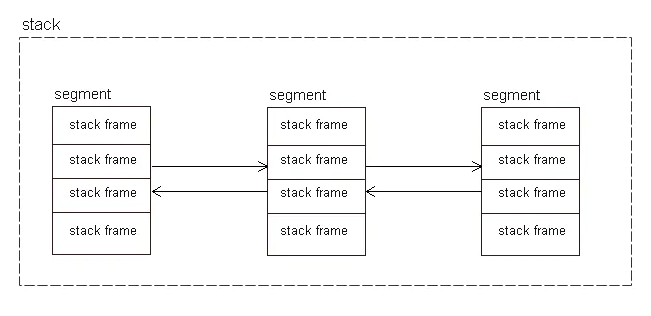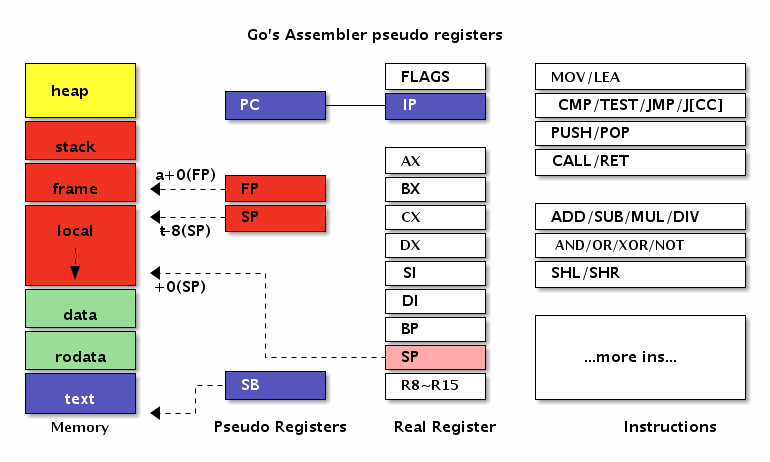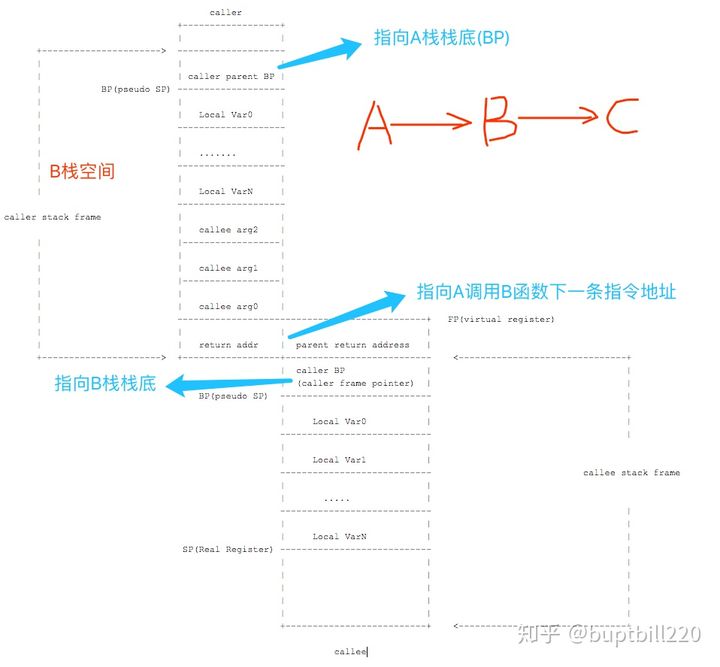Golang中Stack的管理
admin
- 2 minutes read - 367 words栈的演变
在 Go1.13之前的版本,Golang 栈管理是使用的分段栈(Segment Stacks)机制来实现的,由于sgement stack 存在 热分裂(hot split)的问题,后面版本改为采用连续栈( [Contiguous stacks](https://docs.google.com/document/d/1wAaf1rYoM4S4gtnPh0zOlGzWtrZFQ5suE8qr2sD8uWQ/pub))机制( 说明)。
分段栈(Segment Stack)
分段栈是指开始时只有一个stack,当需要更多的 stack 时,就再去申请一个,然后将多个stack 之间用双向链接连接在一起。当使用完成后,再将无用的 stack 从链接中删除释放内存。 segment stack
segment stack
可以看到这样确实实现了stack 按需增长和收缩,在增加新stack时不需要拷贝原来的数据,系统使用率挺高的。但在一定特别的情况下会存在 热分裂(hot split) 的问题。
当一个 stack 即将用完的时候,任意一个函数都会导致堆栈的扩容,当函数执行完返回后,又要触发堆栈的收缩。如果这个操作是在一个for语句里执行的话,则过多的 malloc 和 free 重复操作将导致系统资源开销非常的大。
如果你对 Stack Frame 不了解的话,可能先阅读一下 Go 语言机制之栈和指针
连续栈(Contiguous stacks)  Contiguous stacks 扩容与收缩
Contiguous stacks 扩容与收缩
连续栈使用了另一种管理机制,每当一个stack 空间不够的时候,直接再申请一个2倍大小的空间,然后再将stack数据拷贝过去,同时修改指向原来stack 的指针到新stack,最后再将旧stack删除。
这种机制可以在当stack 空间快用尽的时候,避免在for语句里频繁触发扩容的问题。也正是官方采用这种机制的原因。
栈的初始化
在上篇文章《 Golang 的底层引导流程/启动顺序》中介绍过,在应用启动时会有一系列的初始化工作,其中就包括对栈的初始化 (源码),调用函数 [stackinit()](https://github.com/golang/go/blob/go1.15.6/src/runtime/stack.go#L158-L170)。
func stackinit() {
if _StackCacheSize&_PageMask != 0 {
throw("cache size must be a multiple of page size")
}
for i := range stackpool {
stackpool[i].item.span.init()
lockInit(&stackpool[i].item.mu, lockRankStackpool)
}
for i := range stackLarge.free {
stackLarge.free[i].init()
lockInit(&stackLarge.lock, lockRankStackLarge)
}
}
这里有两个很重要的栈变量,一个是 stackpool,另一个是 stackLarge,两者均为 global pool 级别,实现为对stack的复用。前者是为每一种规格的大小以链接的形式存储可复用stack信息,共有 _NumStackOrders 类。后者为 large stack ,即大小>32K的全局栈。
在应用刚开始时,会分别对这两种全局stack变量进行初始化。
扩容
函数 newstack()。在编译时调用的是 runtime.morestack() 函数。
当G的堆栈空间不够用时,系统会再申请一块两倍大小( 源码)的空间,然后将原堆栈数据拷贝过去,再删除原来的堆栈。
步骤
- 申请两倍大小空间
- 修改
G的状态,将_Grunning改为_Gcopystack,函数[casgstatus()](https://github.com/golang/go/blob/go1.15.6/src/runtime/proc.go#L804-L842) - 拷贝旧数据到新堆栈
[copystack()](https://github.com/golang/go/blob/go1.15.6/src/runtime/stack.go#L838-L917),并调整指针到新堆栈地址[gentraceback()](https://github.com/golang/go/blob/go1.15.6/src/runtime/traceback.go?L=98),最后释放旧堆栈[stackfree()](https://github.com/golang/go/blob/go1.15.6/src/runtime/stack.go#L421-L496) - 再恢复
G的状态,将_Gcopystack为_Grunning,函数[casgstatus()](https://github.com/golang/go/blob/go1.15.6/src/runtime/proc.go#L804-L842)
收缩
当一个 G 占用的stack非常大,后期却很少使用的stack,这时候则会有大量的stack处于空间状态,我们需要对空间进行收缩,以释放资源。
收缩原则
- 在GC期间,如果一个goroutine未使用stack的大小占用超过X% ,则需要将其复制到一个small stack中。当需要的时候再进行扩容。
- 在GC期间,如果一个goroutine未使用stack的大小占用超过X%,将其stack guard 降低到一个较小的值。如果它在下一次GC时没有受到保护,则将其复制到一个small stack 中。
目前的状态是在GC期间,如果一个goroutine使用大小小于其stack的1/4,则释放stack 底部的1/2。同样调用的是 [copystack()](https://github.com/golang/go/blob/go1.15.6/src/runtime/stack.go#L838-L917) 函数,此函数内会进行新栈的创建。
栈的释放
对stack的申请与释放请参考 《 goroutine栈的申请与释放》
其它
Stack frame layout
Stack Frame 是指函数运行时占用的内存空间,是栈上的数据集合,它包括:
- Local variables
- Saved copies of registers modified by subprograms that could need restoration
- Argument parameters
- Return address
FP,SP,PC ,SB
FP: Frame Pointer– Points to the bottom of the argument listSP: Stack Pointer– Points to the top of the space allocated for local variablesPC: Program Counter – jumps and branchesSB: Static base pointer – global symbols
所有用户空间的数据都可以通过FP/SP(局部数据、输入参数、返回值)和SB(全局数据)访问。 通常情况下,不会对SB/FP寄存器进行运算操作,通常情况以会以SB/FP/SP作为基准地址,进行偏移解引用 等操作。
伪SP是一个比较特殊的寄存器,因为还存在一个同名的SP真寄存器。真SP寄存器对应的是栈的顶部,一般用于定位调用其它函数的参数和返回值。
当需要区分伪寄存器和真寄存器的时候只需要记住一点:伪寄存器一般需要一个标识符和偏移量为前缀,如果没有标识符前缀则是真寄存器。比如(SP)、+8(SP)没有标识符前缀为真SP寄存器,而a(SP)、b+8(SP)有标识符为前缀表示伪寄存器。
// Stack frame layout
//
// (x86)
// +------------------+
// | args from caller |
// +------------------+ <- frame->argp
// | return address |
// +------------------+
// | caller's BP (*) | (*) if framepointer_enabled && varp < sp
// +------------------+ <- frame->varp
// | locals |
// +------------------+
// | args to callee |
// +------------------+ <- frame->sp
//
// (arm)
// +------------------+
// | args from caller |
// +------------------+ <- frame->argp
// | caller's retaddr |
// +------------------+ <- frame->varp
// | locals |
// +------------------+
// | args to callee |
// +------------------+
// | return address |
// +------------------+ <- frame->sp
可以看到 x86 和 arm 架构布局是不一样的。目前来说,我们一般只关注 x86 架构布局就可以了,必须arm还不是主流。
调用栈
这里以一个函数调用过程A->B->C为例了来解释调用栈过程
分配从高到低顺序进行。
推荐阅读针对 heap 的GC: Go:内存管理与内存清理,
参考
- https://draveness.me/system-design-memory-management/
- https://golang.design/under-the-hood//zh-cn/part2runtime/ch06sched/stack/
- https://studygolang.com/articles/2917
- https://guidao.github.io/asm.html
- https://segmentfault.com/a/1190000019753885
- https://zhuanlan.zhihu.com/p/56750445
- Go 语言机制之栈和指针
- Contiguous stacks
- 聊一聊goroutine stack
- Go: Goroutine 的堆栈大小是如何演进的
- Go:内存管理与内存清理
- https://www.jianshu.com/p/20c1855d1b9c
- https://segmentfault.com/a/1190000019570427
- https://github.com/jukylin/blog/blob/master/Go%E6%BA%90%E7%A0%81%EF%BC%9A%E5%8D%8F%E7%A8%8B%E6%A0%88.md
- https://medium.com/a-journey-with-go/go-how-does-the-goroutine-stack-size-evolve-447fc02085e5 ( 中文)
- https://docs.google.com/document/d/13v_u3UrN2pgUtPnH4y-qfmlXwEEryikFu0SQiwk35SA/pub
- https://docs.google.com/document/d/1un-Jn47yByHL7I0aVIP_uVCMxjdM5mpelJhiKlIqxkE/edit#heading=h.bvezjdnoi4no